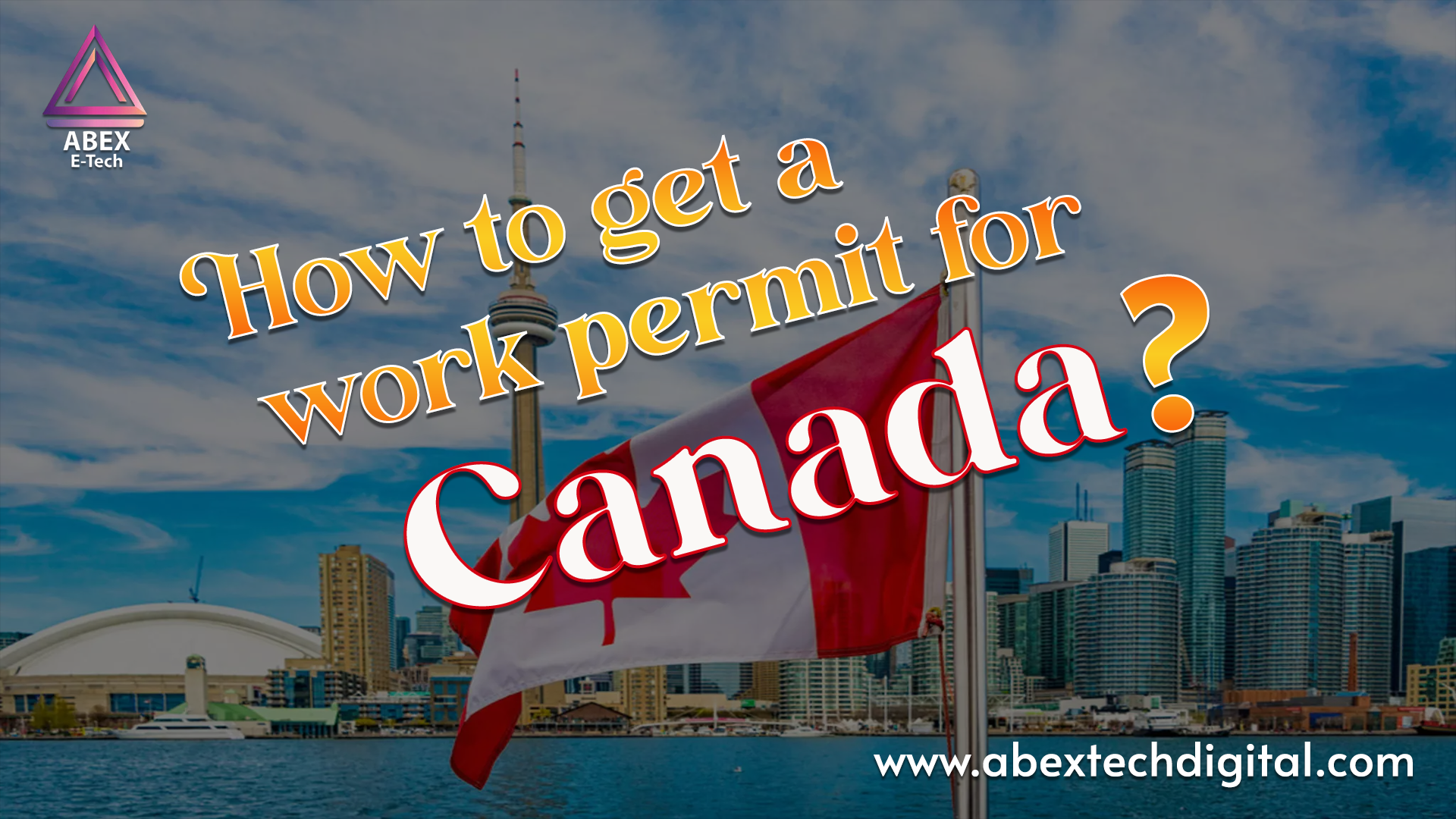How to get a Work Permit for Canada? | Step by Step All Process
A Canada work permit is a document that allows foreign nationals to work and grow their careers in Canada. Canada is not just an eye candy but also a land full of opportunities ready for you to grow.
Source: https://images.app.goo.gl/FbmJLACCh6vHbM9L7
Canada allows thousands of work visas every year to foreign workers who qualify for the eligibility criteria set by the Canadian Immigration Agency. We at Abex Technologies are here to help you apply for a work permit in Canada. Approximately 75% of Canada.ca work permits are processed in a 4-month. So what are you waiting for? Read our blog below, “How to get a Canada work permit?” and be ready to apply for a Canada work permit visa today!
But if Canada is not for you, then we’ve got other options for you as well!
Read our other blogs:
How to get a Romania work permit? & How to get a Portugal work permit?
How to get a Luxembourg work permit?
Now, let’s get back to getting a work permit in Canada!
What Benefits will a Canada work permit give you?
If you have succeeded in getting a work permit in Canada, then the next step is to identify the benefits it will allow you. You can get:
Employment Opportunities
A work permit in Canada will allow you to legally work in Canada which will open doors to multiple opportunities in different sectors. These opportunities will enhance your resume and increase your professional experience and skills.
Pathway to Permanent Residency
Working in Canada can be a stepping stone toward permanent residency. Many work permit holders eventually apply for permanent residence through programs like the Canadian Experience Class or the Provincial Nominee Program.
Diverse Work Environment
Canada provides a diverse work environment that is all-inclusive; meaning anyone with the skills gets a fair chance. Working in Canada provides exposure to a multicultural workplace and helps build a global professional network.
Who wouldn’t want them, right?
Let’s move on to the next step. Identifying the types of Canadian work visas and how they differ from one another. Yes! There are many work permits in Canada. Let’s acknowledge them together.
What are the Types of Canada work permits?
Canada acknowledges different types of employment and organizations. So, Canadian Immigration has made getting a work permit easy by classifying them into several types. Let’s explain them in detail.
Source: https://images.app.goo.gl/R7hR8GhGFKZTsswN9
Canada provides you the following work permits:
- Employer-Specific Work Permits
- Open Work Permits
- Special Work Permits
There are also different subcategories of Canada.ca work permits. Let’s explain them all:
| Types of Work Permits | Subtypes of Work Permits | Description | Processing Time | Processing Fee |
| Employer-Specific Work Permits | Temporary Foreign Worker Program (TFWP) | Required to fill temporary labor and skill shortages with foreign workers. | 2-4 months | CAD 155 |
| Intra-Company Transfers | Permits for employees transferring to a Canadian branch of their company. | 2-3 months | CAD 155 | |
| International Mobility Program (IMP) | Permits for those exempt from the Labour Market Impact Assessment (LMIA) process, often due to trade agreements. | 2-3 months | CAD 155 | |
| Open Work Permits | Post-Graduation Work Permit (PGWP) | Permits for international students who have graduated from a Canadian educational institution. | 3-5 months | CAD 255 |
| Spousal Open Work Permit | Allows spouses or common-law partners of certain temporary residents to work in Canada. | 3-5 months | CAD 255 | |
| International Experience Canada (IEC) | Permits for young people from certain countries to work and travel in Canada. | 1-2 months | CAD 156 | |
| Special Work Permits | Bridging Open Work Permit (BOWP) | Allows those applying for permanent residence to continue working while their application is processed. | 2-4 months | CAD 155 |
| Global Skills Strategy (GSS) | Permits for highly skilled workers with faster processing times. | 2 weeks | CAD 155 |
Now for the main part: How to get a Canada work permit?
Getting a Canada work permit visa includes a few simple but mandatory steps that must be followed with precision. All the requirements must be met with care and attention. So, let’s get to it!
The perfect guide to apply for a Canada work permit
The first step is to determine if you need a work permit and which type of permit suits your needs. You can decide this from the table above.
1. Check the Eligibility Criteria
Let’s say that you have decided, what now?
The first thing you need is:
Job Offer:
Does your job offer require an LMIA (Labor Market Impact Assessment)? If so, you must ensure that your employer has a positive LMIA.
Permit Type:
Your application process may differ depending on whether you have a specific job offer, are a recent graduate, or are applying for an open work permit.
2. Gather Required Documents
Once you have qualified for the eligibility criteria for your certain work visa in Canada. After this, start gathering all required documents. They may include:
- An application form
- Job offer Proof
- Passport Copy
- Photos
- Proof of your current status in your home country
- Medical Exam Results
3. Submit the Application
You can apply online through the Immigration, Refugees and Citizenship Canada (IRCC) website.
Source: https://images.app.goo.gl/RpH9Tvb7cr8EcHms7
You can simply follow these steps:
- Create an account at the IRCC website
- Fill out the required forms accurately
- Upload all documents in the mentioned format.
- Pay the processing fee using a credit card or any other accepted payment methods
4. Biometrics
If your application requires biometrics, you will receive instructions on where and how to provide your fingerprints and photo. Biometrics are used for background checks and to confirm your identity.
5. Wait for Processing
Processing times change contingent upon the sort of work permit and the applicant’s nation of residence. After this, Check your application’s status online. Processing times generally range from a few weeks to several months.
6. Receive the Canada work permit.
A letter of introduction will arrive after your application gets approved. When you arrive in Canada, a border services officer will issue you your work permit. Make sure you keep a copy of your work permit with you at all times while residing in Canada.
We hope this information helps you take the next big step and apply for a Canada work permit today!
Source: https://images.app.goo.gl/zVrgCnMfdtkBcMzf6
If you have any questions or queries, contact us at www.abextechdigital.com, and we’ll be there to help you ASAP! Abex Technologies is a leading pioneer in providing exemplary digital solutions for all types of businesses. So what’s the wait? Do you have a digital need that needs to be met? Contact us today at +922 51 6103124.
FAQs
A Canada work permit is a document that allows me to work legally in Canada. It’s required for foreign nationals who want to work in Canada temporarily.
You can work legally in Canada and gain international experience. It may help me in applying for permanent residency later on.
Employer-Specific Work Permits: Includes TFWP, Intra-Company Transfers, and IMP.
Open Work Permits: Includes PGWP, Spousal Open Work Permit, and IEC.
Special Work Permits: Includes BOWP and GSS.
You should consider my job offer, whether an LMIA is required, and if I am a recent graduate or applying for an open work permit. Check the details and requirements for each permit type to choose the right one.
1. Check Eligibility: Determine if I need a work permit and which type suits me.
2. Gather Documents: Collect all required documents, such as the application form, job offer proof, passport copy, and medical results.
3. Submit Application: Apply online through the IRCC website and pay the processing fee.
4. Provide Biometrics: If required, follow instructions to provide fingerprints and photos.
5. Wait for Processing: Check the status online and wait for the permit to be processed.
Processing time and fees vary but generally range from a few weeks to several months, depending on the type of permit and my country of residence.






